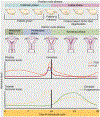Biomaterials and Contraception: Promises and Pitfalls
- PMID: 31701311
- PMCID: PMC7202983
- DOI: 10.1007/s10439-019-02402-1
Biomaterials and Contraception: Promises and Pitfalls
Abstract
The present state of reproductive and sexual health around the world reveals disparities in contraceptive use and effectiveness. Unintended pregnancy and sexually transmitted infection transmission rates remain high even with current prevention methods. The 20th century saw a contraceptive revolution with biomedical innovation driving the success of new contraceptive technologies with central design concepts and materials. Current modalities can be broadly categorized according to their mode of function: reversible methods such as physical/chemical barriers or hormonal delivery devices via systemic (transdermal and subcutaneous) or localized (intrauterine and intravaginal) administration, and nonreversible sterilization procedures such as tubal ligation and vasectomy. Contraceptive biomaterials are at present dominated by well-characterized elastomers such as polydimethylsiloxane and ethylene vinyl acetate due to their favorable material properties and versatility. Contraceptives alter the normal function of cellular components in the reproductive systems to impair fertility. The purpose of this review is to highlight the bioengineering design of existing methods, explore novel adaptations, and address notable shortcomings in current contraceptive technologies.
Keywords: Barrier technologies; Bioengineering design; Hormonal delivery devices; Reproductive health; STI prevention.
Figures





Similar articles
-
Canadian Contraception Consensus (Part 1 of 4).J Obstet Gynaecol Can. 2015 Oct;37(10):936-42. doi: 10.1016/s1701-2163(16)30033-0. J Obstet Gynaecol Can. 2015. PMID: 26606712 English, French.
-
Canadian Contraception Consensus (Part 2 of 4).J Obstet Gynaecol Can. 2015 Nov;37(11):1033-9. doi: 10.1016/s1701-2163(16)30054-8. J Obstet Gynaecol Can. 2015. PMID: 26629725 English, French.
-
New technologies in contraception.BJOG. 2009 Jan;116(2):230-9. doi: 10.1111/j.1471-0528.2008.01985.x. BJOG. 2009. PMID: 19076955 Review.
-
Canadian Contraception Consensus (Part 3 of 4): Chapter 7--Intrauterine Contraception.J Obstet Gynaecol Can. 2016 Feb;38(2):182-222. doi: 10.1016/j.jogc.2015.12.002. Epub 2016 Feb 26. J Obstet Gynaecol Can. 2016. PMID: 27032746 English, French.
-
Birth control techniques in China.China Popul Newsl. 1983 Dec;1(2):1-7. China Popul Newsl. 1983. PMID: 12312957
Cited by
-
Biomaterials science and engineering to address unmet needs in women's health.MRS Bull. 2022;47(8):864-871. doi: 10.1557/s43577-022-00389-0. Epub 2022 Sep 29. MRS Bull. 2022. PMID: 36196217 Free PMC article. Review.
-
Bioengineering Approaches for Placental Research.Ann Biomed Eng. 2021 Aug;49(8):1805-1818. doi: 10.1007/s10439-020-02714-7. Epub 2021 Jan 8. Ann Biomed Eng. 2021. PMID: 33420547 Review.
-
Recent progress in advanced biomaterials for long-acting reversible contraception.J Nanobiotechnology. 2022 Mar 17;20(1):138. doi: 10.1186/s12951-022-01329-5. J Nanobiotechnology. 2022. PMID: 35300702 Free PMC article. Review.
References
-
- World Health Organization. ‘Family Planning and Contraception’. 2018.
-
- Rowley J et al. ‘Global and Regional Estimates of the Prevalence and Incidence of Four Curable Sexually Transmitted Infections in 2016’. WHO Bulletin, 2019. - PubMed
-
- World Health Organization. ‘Report on global sexually transmitted infection surveillance 2018’. 2018.
-
- McKeen L ‘Elastomers’ In: The Effect of Sterilization on Plastics and Elastomers., William Andrew Publishing, 2012. pp. 319–353
Publication types
MeSH terms
Substances
Grants and funding
LinkOut - more resources
Full Text Sources
Medical

